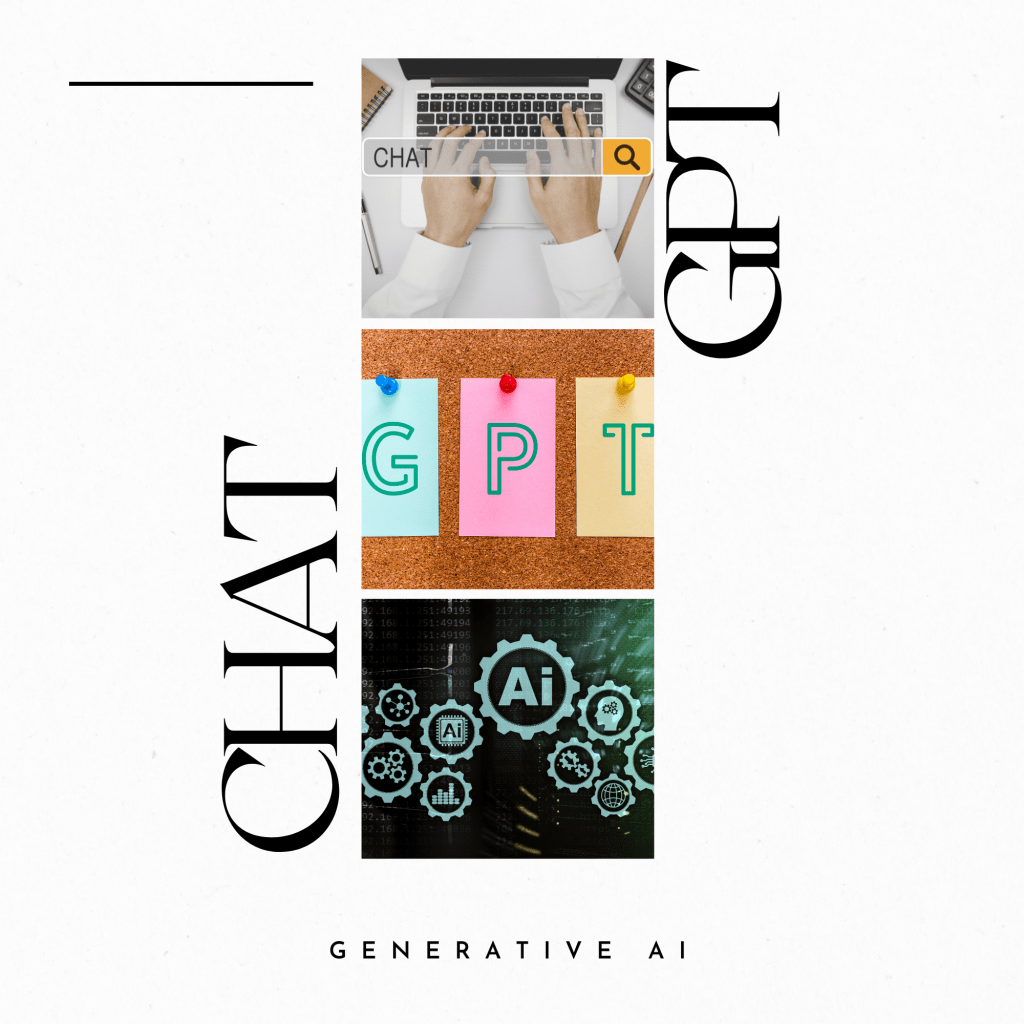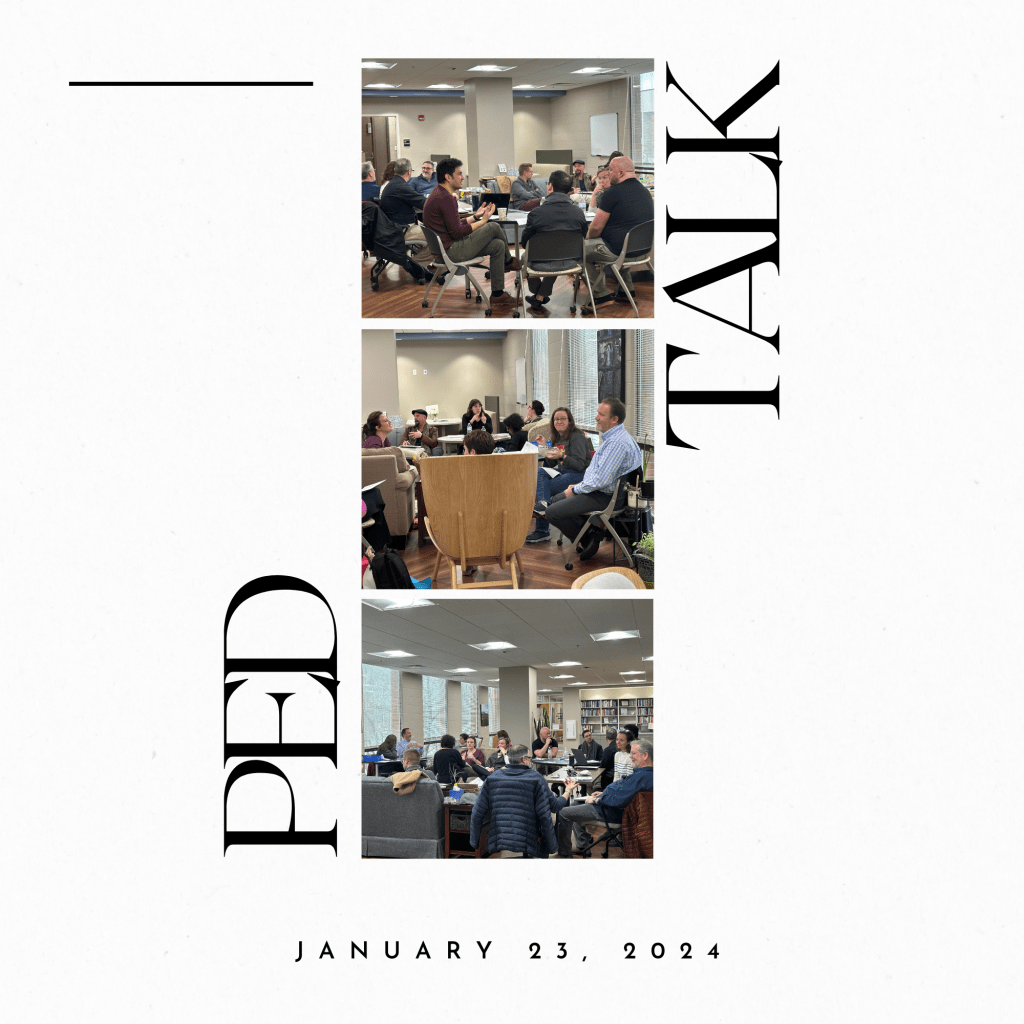The CTL has compiled and curated resources as a service to support teaching decisions along a range of faculty philosophical positions related to generative writing tools such as ChatGPT. Even if you’d rather not bring AI into your courses, you still need to understand how these tools work and be able to speak knowledgeably about them with students.

“Let’s Talk about ChatGPT and Generative AI” from the Fall 2023 Faculty Workshop
Alex McAllister, Stacey Peebles, Sami Sweis, and Kari Young led a session at the Fall Faculty Workshop on August 17. The handout from this session includes: the agenda for the session, links to how to get started with ChatGPT, sample syllabi language, and a short list of useful language related to generative AI.
Note: This is a rapidly-growing, quickly-changing topic; we will continue to add to this webpage as more information becomes available and our experience grows, particularly as more faculty develop and use these tools in assignments. We welcome your input, suggestions, and questions at ctl@centre.edu.
In addition to sources cited in text, information in this website comes from the following two sources: Mollick & Mollick (2023) and the University of Delaware.

Introduction
Advanced automated tools – artificial intelligence or machine learning tools such as ChatGPT or Dall-E 2 that are sometimes described as “generative” or “autogenerative” tools – use sophisticated technology and very large data sets to create realistic writing, images, or other artifacts in response to natural language queries and prompts. They are very easy to use and some of their output is very difficult to distinguish from human-generated material. The impact of these tools in the classroom context is just beginning to be discussed.
Some questions being asked about the use of advanced automated tools in their course(s)include:
- Should students be allowed to use these tools?
- How can we support their learning about these tools and the many complex, interesting, and rapidly-developing issues that surround them?
- What are the most pressing issues – practical, pedagogical, and ethical – related to the use of these tools?
Strategies and Resources for Teaching with these tools
Strategies and Resources for Teaching with these tools
Much thought and ideas are emerging related to how to use generative AI with your classes. Below are three categories to consider with your planning.
Category 1: Cultivate Pedagogical Practices that Lean into the Software’s Abilities.
- ChatGPT Assignments to use in your classroom today. (Yee, Kevin; Whittington, Kirby; Doggette, Erin; and Uttich, Laurie, “ChatGPT Assignments to Use in Your Classroom Today” (2023). UCF Created OER Works. 8. https://stars.library.ucf.edu/oer/8
- How can ChatGPT intersect with Blooms Taxonomy (Christine Rivers and Anna Holland). https://www.timeshighereducation.com/campus/how-can-generative-ai-intersect-blooms-taxonomy
- ChatGPT and generative AI: 25 applications to support student engagement (Seb Dianati and Suman Laudari, Charles Darwin University). https://www.timeshighereducation.com/campus/chatgpt-and-generative-ai-25-applications-support-student-engagement
- In Medium Blog Post: “Update Your Course Syllabus for ChatGPT” (Ryan Watkins, George Washington University)
- From Illinois State, Center for Integrated Professional Development, AI-Generated Content in the Classroom: Considerations for Course Design.
- From Faculty Focus: Embrace the Bot:Designing Writing Assignments in the Face of AI (Eric Prochaska, Mt. Hood College)
- From Faculty Focus: Level up Assessments with ChatGPT.(Shellon Samuels-White, Mico University College)
Category 2: Detect and Neutralize the Software. Despite claims from detection tools for AI text generators, most have shown to have false positives leading to false accusations of cheating. For further reading about use of these detection tools or other ways neutralize the effects see:
- From Sung Kim AKA “Geek Culture” on Medium: “How to Detect OpenAI’s ChatGPT Output”
- From NPR: “A College Student Created an App That Can Tell Whether AI Wrote an Essay” (Emma Bowman)
- From WAC Clearinghouse, AI Text Generators and Teaching Writing: Starting Points for Inquiry. (Emma Mills)
Category 3: Teach Ethics, Integrity and Career-Related Skills. There are other ways to increase academic integrity. These are some sources that tap into good pedagogy about academic integrity.
- From Johns Hopkins University Press Resource Sheet and Brief Introduction for Considerations of Academic Integrity.
- On the Tea for Teaching Podcast: “ChatGPT” (Robert Cummings and Marc Watkins, University of Mississippi)
- On the Brookings Institution Blog: “ChatGPT: Educational Friend or Foe?” (Kathy Hirsh-Pasek and Elias Blinkoff, Temple University)
- In Wired: “ChatGPT Is Making Universities Rethink Plagiarism” (Sofia Barnett)
Use/No Use of these tools
There are at least 4 ways instructors may imagine these tools for student use:
Use prohibited
Students are not allowed to use advanced automated tools (artificial intelligence or machine learning tools such as ChatGPT or Dall-E 2) on assignments in this course. Each student is expected to complete each assignment without substantive assistance from others, including automated tools.
Use only with prior permission.
Students are allowed to use advanced automated tools (artificial intelligence or machine learning tools such as ChatGPT or Dall-E 2) on assignments in this course if instructor permission is obtained in advance. Unless given permission to use those tools, each student is expected to complete each assignment without substantive assistance from others, including automated tools.
Use only with acknowledgement
Students are allowed to use advanced automated tools (artificial intelligence or machine learning tools such as ChatGPT or Dall-E 2) on assignments in this course if that use is properly documented and credited. For example, text generated using ChatGPT-3 should include a citation such as: “Chat-GPT-3. (YYYY, Month DD of query). “Text of your query.” Generated using OpenAI. https://chat.openai.com/” Material generated using other tools should follow a similar citation convention.
Use is freely permitted with no acknowledgement
Students are allowed to use advanced automated tools (artificial intelligence or machine learning tools such as ChatGPT or Dall-E 2) on assignments in this course; no special documentation or citation is required.
The Center for Teaching & Assessment of Learning at the University of Delaware has developed four sample syllabus statements following these four lenses: University of Delaware Syllabus Statements
Sample Syllabi Policy Statements
Many campuses are working out classroom policies for use AI Generative tools. Colleagues in other teaching and learning centers have compiled sample syllabi statements in a Google Doc: Sample Syllabi Statements Repository.
Here is a shorter list that we have curated. Feel free to add your statement: Syllabi Statement Shortlist
General Information on ChatGPT in Higher Education
- EdSurge On Air Podcast Episode: “ChatGPT Has Colleges in Emergency Mode to Shield Academic Integrity”
- WCET Frontiers Blog: “Is AI the New Homework Machine? Understanding AI and Its Impact on Higher Education”
- TOPcast: The Teaching Online Podcast Episode: “ChatGPT: Friend or Foe?”
*To access The Chronicle for Higher Education, visit the Grace Doherty Library website. Under the “Find” menu option on the page, choose “All Databases”. On the next webpage, Databases A-to-Z, choose “C-D”, and find The Chronicle for Higher Education.